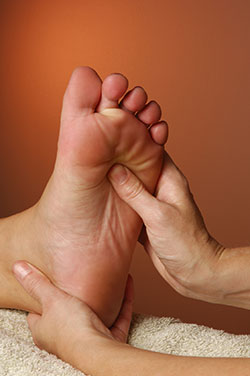
“Reflexology” is modern terminology for a very ancient and safe therapy of manipulation and massage of specific points on the feet and hands. Reflexology was evident in the Egyptian civilization more than 4000 years ago. Eastern cultures also had similar practices 5000 years ago. The biggest influence for reflexology has come from America where the practice of massaging the reflex zones is thought to derive from ancient folk medicine used by Native American Indians. This may have been passed down to them by the Incas who were thought to have refined the Asian Indian techniques. Reflexology as we know it today in the West has its’ origins in the study of “Zone Therapy”. In early 1900’s massage techniques were developed in Germany called “reflexzonemassage”
In 1913 an American called Dr William Fitzgerald studied “Zone Therapy”. Dr Fitzgerald described a system of ten longitudinal zones in the body, and the importance of this was that within each zone there were energy links between certain areas. Dr Joe Riley and his wife Elizabeth were friends and supporters of Dr Fitzgerald. In the 1930’s one of Dr Riley’s students of “Zone Therapy”, Mrs. Eunice Ingham became the main pioneer of “Reflexology” as it is known today. Mrs. Eunice Ingham was working as a physiotherapist in an orthopedic hospital. Her basic philosophy was to help people help themselves. By separating the reflexes of the feet and hands from “Zone Therapy”, she called her work “Compression Massage” but later changed it to “Reflexology”. Reflexology was introduced to Britain in the early 1960’s by a student of Eunice Ingham called Mrs. Doreen Bayly, and it was this lady who trained and enlightened Reflexologists throughout Britain and the Continent. A German practitioner, Mrs. Hanne Marquardt who trained with Eunice Ingham, first described the transverse zones on the feet and hands which helped interpret the arrangement of body parts more accurately within the original longitudinal zones.
Holistic Reflexology
When you look at your feet you discover that there is a perfect microcosm or mini-image of the whole body. All the organs, glands and body parts represented in the foot are laid out in the same arrangement as in the body, as a perfect reflection. Even the inside of the foot corresponds to the natural curves in the spine. Reflexologists specify that there are ten energy zones that run the length of the body from head to toe, five on each side of the body ending in each foot and running down the arms to the tops of the fingers. In Foot Reflexology, not only do these zones run lengthwise, but they pass through the body so that a zone located on the front of the foot can also be reached from behind. All the organs and parts of the body lie along one or more of these zones. Each zone can be considered a channel for the intangible life energy called Chi, or qi in oriental medicine and martial arts. Modern reflexology is both a science and an art.
Reflexology gives the best results when the Reflexologist works with dedication, patience, focused intention and loving care.
Communication of touch is an extremely basic instinctive need. Reflexologists stimulate or work any zone in the Client’s foot or hand by applying pressure with their own thumbs and fingers this in turn affects the entire zone throughout the Client’s body. How it works is still a mystery. The fact that it works is proven every day. Reflexology is not a medical treatment. Reflexologists do not diagnose illness, treat diseases, nor do they practice medicine or heal (only licensed physicians are allowed by law to practice medicine). The aim of all health care practitioners, whether holistic or allopathic (treatment by drugs), should be to work for the patients benefit. To this end, reflexology when practiced in agreement with sound medical advice from doctors, is now being encouraged as a complementary therapy.
Benefits of Holistic Reflexology
“Reflexology may often help stimulate creativity and productivity. Each session of reflexology provides the quiet time so necessary to let new ideas gestate, allowing mental energy to be more creative and productive. Reflexology nurtures relationships. When you feel good others respond. Feeling good is contagious and can change the atmosphere of your work place or home with your colleagues, family and friends.”
Reflexology is a safe and gentle holistic treatment that is suitable for men and women of all ages and physical conditions. In certain circumstances there may be medical contra-indications to Reflexology. Should this happen the client will be advised to seek a medical referral before having a Reflexology treatment. Reflexology may be considered as a therapy for preventative health care. When a body is well balanced a person is in good shape to ward off illness. Reflexology helps alleviate the effects of stress. 75% of disease is estimated to be stress related. Reflexology induces deep relaxation. By placing the Client in a “safe place” and allowing the nervous system to calm down and function more normally. Circulation then proceeds smoothly as the “Flight or Flight Syndrome” is calmed, and blood flow is improved, oxygen reaches all the cells. The body seeks homeostasis (natural functioning of all the body systems) and natural healing can take place. The experience itself does not “heal” it merely creates the circumstances through which “self healing” can occur. The client experiences a sense of well-being at all levels. During reflexology the body is normalized as the seven energy centers known in eastern medicine as the Chakras are stimulated. The body returns to its natural rhythm as energy flows, helping the body, mind and spirit into new balances.
Reflexology treatment information
The 1st appointment takes approximately 1 hour, which includes a brief outline for the treatment and the client’s confidential health history information. As with all Reflexology and Massage therapies, Client’s should be aware that there may be certain minor reactions apart from the initial feelings of well-being. After the treatment it is advisable to rest for 10-15 minutes and drink lots of water as these types of temporary signs or reactions naturally show that body’s eliminatory processes are responding to the treatment. It is important to recall and give-feed back information about any signs of discomfort or good feelings of wellbeing at the next appointment so that the Reflexologist may adjust the treatment plan to suit the individual’s specific needs.
People who experience reflexology often say they feel as though they are walking on air for hours after the treatment. A course of treatments is advised and benefits often continue for some days after the treatment.
